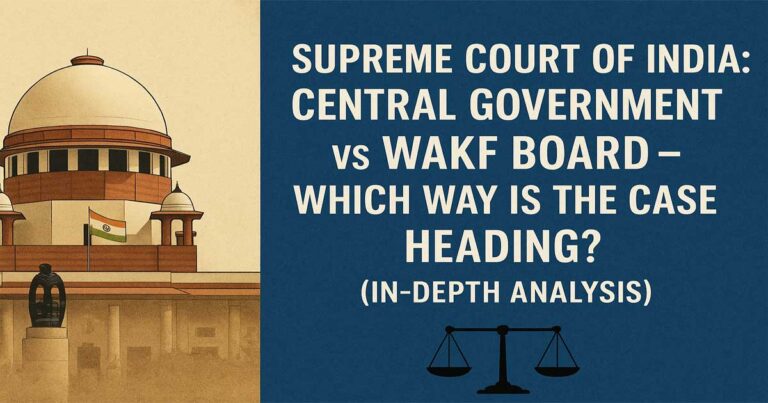In a landmark case before the Supreme Court of India, the Central Government and the Wakf Board are at odds. This case is not confined to property law alone; rather, it touches upon deeper layers within the country’s religious, social, and political structure. In today’s discussion, we will explore the direction in which this case is heading and what the potential outcomes could be.
The Beginning of the Case: Where Did It All Start?
In recent years, disputes regarding Wakf properties have been on the rise across various states in India. In many instances, allegations have been raised that some Wakf properties are being privately occupied or misused illegally. The Central Government claims that there is a lack of transparency in the functioning and property management of the Wakf Boards. In this context, the central government approached the Supreme Court, where the main question raised is:
To what extent should Wakf properties be under government control?
On the other hand, the Wakf Boards argue that their autonomous rights are constitutionally guaranteed, and the government cannot directly intervene in the management of these properties.
The Core of the Debate
The central issues of this case are twofold:
- Ownership and Management of Wakf Properties:
Can the government establish ownership rights over Wakf properties, or should they remain entirely under the control of religious institutions? - Role of a Secular State:
India’s Constitution has established the principle of secularism. So, if the government directly intervenes in the management of Wakf Boards, would it be contrary to the secular principles enshrined in the Constitution?
The answers to these two questions are not confined to legal arguments alone — they also involve religious sensitivities, public trust, and the social stability of the country.
The Supreme Court’s Stance: What We Know So Far
During the hearings, the Supreme Court has so far adopted a balanced stance. The court has made it clear that the autonomy of religious institutions should be respected; however, it is the duty of the state to ensure that no religious institution is above the Constitution.
From the observations of the judges, it can be inferred that:
- The importance of transparency and accountability is increasing.
- The state may have a specific role in preventing the misuse of Wakf properties.
- However, this role would be limited and must align with constitutional principles.
In other words, the court is likely to deliver a verdict that strikes a balance between the rights of religious institutions and the state’s demand for transparency.
Potential Impact: What Could Happen in the Coming Days?
The verdict in this case could bring about far-reaching changes in the management and property administration of religious institutions in India.
Several possible directions include:
- Implementation of stricter regulations for the registration and management of Wakf properties.
- Making annual audits and reporting mandatory for religious institutions.
- The government may assume a role in monitoring within specified limits.
- Measures to prevent corruption and misuse while preserving the independence of religious institutions.
If the court partially agrees with the government’s argument, similar questions may arise in the future regarding the management of other religious institutions, such as temples, churches, or gurudwaras.
Viewing from a Humanitarian Perspective
An important aspect of this case is the psychology of the common people.
Wakf property, especially for the impoverished Muslim community, acts as a kind of social safety net. If there is corruption in the management of this property, it is the common people who suffer the most. On the other hand, if the state imposes excessive control, it could infringe on religious freedom—potentially leading to a deep crisis of trust.
Wakf property, especially for the impoverished Muslim community, acts as a kind of social safety net. If there is corruption in the management of this property, it is the common people who suffer the most. On the other hand, if the state imposes excessive control, it could infringe on religious freedom—potentially leading to a deep crisis of trust.
Conclusion: Which Way Is the Case Heading?
The final verdict is yet to come. However, based on the hearings so far, it seems that the Supreme Court aims to adopt a viewpoint that seeks to establish a balanced relationship between the state and religious institutions.
Ultimately, the ruling in this case will not be confined to legal papers—it will echo in India’s religious, social, and political spheres for years to come.
We eagerly await the direction this historic case will take.
Frequently Asked Questions
What is the ongoing case between the Central Government and the Waqf Board in the Supreme Court?
The core issue of the case revolves around the ownership, management, and transparency of Waqf property. The central government seeks to bring transparency to the management of Waqf properties, while the Waqf Board aims to retain its autonomous rights.
What is Waqf property?
Waqf property refers to assets donated for religious purposes in Islam, primarily intended for use in charitable and social welfare activities. Such properties are typically dedicated permanently for religious or public welfare purposes.
What could be the potential impact of the ruling in this case?
After the ruling, there may be new laws or regulations introduced to ensure stricter rules and transparency in the management of Waqf properties. At the same time, efforts to protect the autonomy of religious institutions will also be a consideration.
What has the Supreme Court indicated so far?
The Supreme Court has indicated that it may deliver a balanced verdict, ensuring that the autonomy of religious organizations is preserved while also allowing the government to maintain limited oversight for preventing corruption.
What is the social significance of the case?
This case is not just a legal battle; it is also a major test of balancing religious freedom, secularism, and social justice in India.
